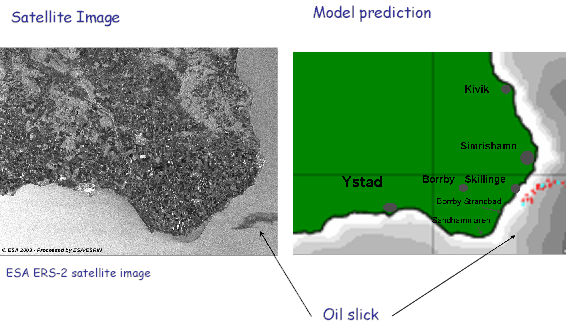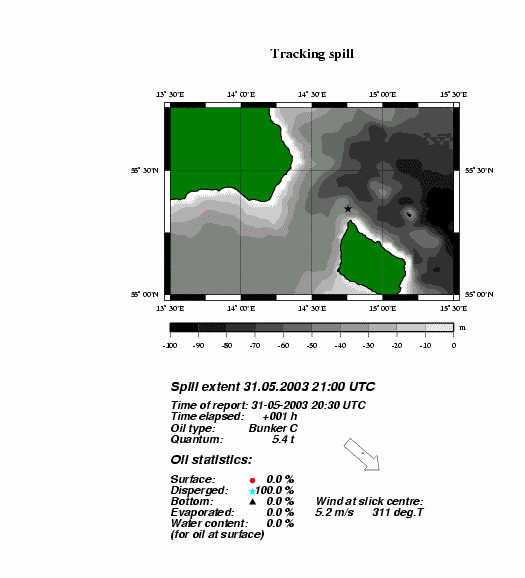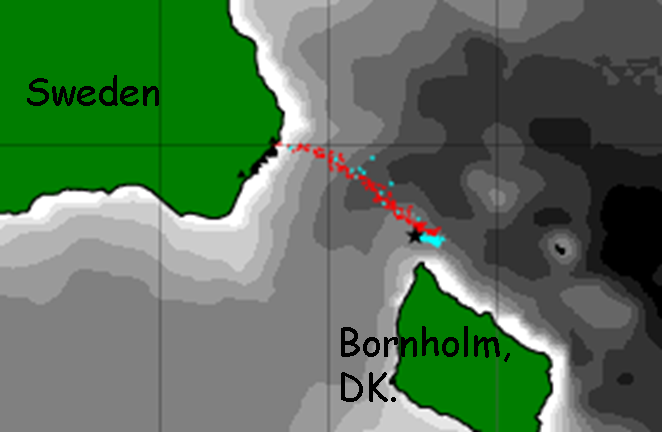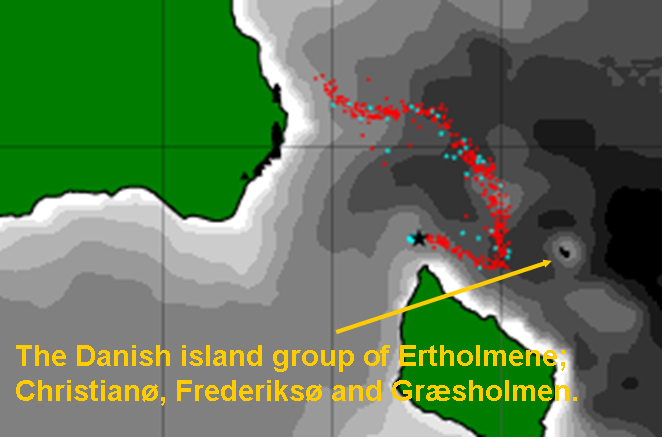The Fu Shan Hai oil spill was
released at 68 meter water depth, and is thus an example of the necessity
of a 3D oil drift model, that takes into account oil drift and dispersion
in the subsurface water column. The oil slick in this case is, some of
time, drifting several kilometres below the surface before it reaches the sea surface - and is thus spread and
moved by different current speed and directions, than if it had been
transported at the sea surface.
The accident
The Chinese bulk carrier “Fu Shan Hai” collided with the Polish freighter
“Gdynia” on Saturday 31 May 2003 about 40 km southwest of Sweden and 4.5
km north of Hammer Odde, Bornholm in the western Baltic Sea. The collision
occurred around 12:25 Danish time and at 20:48 Fu Shan Hai
sank at 68 meters water depth from where it began to leak oil. Fu Shan Hai
was carrying; 66.000 tons of carbonate of potash, 1680 tons of heavy fuel
oil, 110 tons of diesel oil and 35 tons of lubricating oil.
Model setup specifications
The ongoing reporting from the authorities of oil observations the following days,
indicate that the oil was discharged discontinuously, in several phases.
Due to uncertain information about the oil discharge phases – the oil
release was specified as a continuous discharge in the simulations. The
discharge was set to 7.2 ton/h from May 31st 2003 at 20:30 UTC to June 12th
2003 at 6:00 UTC. The applied oil type was heavy fuel oil (Bunker C). The
simulation can thus be considered as “a
worse case” – since the amount of oil cleaned-up was not taken into
account in the simulation and oil was released continuously in the model.
The oil released was specified at 68 meters water depth in the model.
Oil slick drift observation
Monday morning
June 2nd an oil slick of about 12
km long and 3 km wide was observed offshore south of the Swedish coast
- drifting towards the coast of Borrby.
Figure 1 below, shows an ESA ERS-2 satellite
image of the oil slick from June 2nd 2003 at 10 p.m. together with the oil
drift model prediction for the same day and time.

Figure 1. ESA ERS-2 satellite image
from June 2nd 2003 at 10 p.m.( same day as the oil spill approaches the
Swedish coast, as seen in the lower right corner ) compared by the 3D oil
drift model result at the same day and time. Red dots indicate oil at sea
surface while light dots indicate oil at subsurface.
On Tuesday morning 3
June 3rd the first oil slicks had stranded on the south coast of Sweden –from Borrby to Sandrishamn. Thursday
evening June 5th the wind changed to a strong westerly wind, which caused
the oil at the Swedish coastline to drift offshore again. During the night
the oil drifted towards Christianø, Frederiksø and Græsholmen – the Danish
island group of Ertholmene – located northeast of Bornholm. Friday June 6th
oil was still leaking from Fu Shan Hai and was also moving towards the
Danish island group of Ertholmene. From early Friday morning three Danish
oil-combating vessels were trying to prevent the oil drifting into the
coast – by dike and collecting of the oil slick. Saturday June 7th oil
polluted the shores and cliffs of Christianø.
3D Oil Drift and Fate Model result
The model predictions were generally in agreement with the oil slick observations described above.
The model predicted a severe oil pollution at the
Swedish southeast coast – from Borrby in the south up to Simrishamn - 3-4
days after the accident - in agreement with observations.
The model predicted an oil pollution of the Swedish coastline to take place 3 June
(4 days after the accident) after which the model predicted the oil along the Swedish coastline
to drift offshore again and eastwards towards the Danish island group of Ertholmene. The oil was predicted to drift
towards the east and strand on Christiansø on June 5.
On the model oil drift animation below one can follow the model
predictions of the different oil weathering
processes parameter as a function of time, that to say the
percentage of oil evaporation, oil dispersed in the subsurface, water
content in the oil, etc.
Red colour indicates oil at the surface, blue
colour oil at subsurface and black colour oil
deposited at either the seafloor or coastlinies.

Simulation series

Figure 2. Simulation time:
03.06.03 05:00 UTC. (57 hrs after the oil spill). During the night of
3 June the oil spill polluted the coastline of Sweden from Borrby to
Sandrishamn.

Figure 3. Simulation
time: 04.06.03 14:00 UTC. (90 hrs after the oil spill) The oil spill
has drifted further northwards to Simrishamn and thus polluted a
larger part of the Swedish coastline.

Figure 4. Simulation time: 05.06.03 07:00 UTC. (107 hrs after the oil spill). The oil spill
has drifted further northwards.

Figure 5. Simulation time: 05.06.03 10:00 UTC. (120 hrs after the oil spill) The oil spill
has now drifted offshore towards the Danish island group of Ertholmene
–northeast of Bornholm - in
agreement with obsrvations.

Figure 6. Simulation time: 06.06.03 07:00 UTC. (135 hrs after the oil spill). During the
morning of 6 June the oil spill drifted onto the coasts of Ertholmene.
In reality the oil first drifted into the island the next morning.
However the simulation did not take into account the three
oil-combating vessels who early Friday morning were preventing the oil
slick to pollute the coastlines.

Figure 7. Simulation time:
09.06.03 10:00 UTC. (206 hrs after the oil spill). Oil release and oil
slick distribution 8-9 days after the accident. From
the release point – at 68-meter depth the simulation indicates an
easterly oil drift under the surface – making the oil spill first to
become visible at the sea surface a distance from the sunken ship.
The model animations
indicate approximately 58% oil floating at the sea surface and
approximately 22% oil drifting in the waters below the sea
surface.
2D model result
The oil drift was also simulated
by use of the MIKE 21-SA 2D oil drift model at DMI. The forecast showed the oil
slick to drift northwest and strand on the Swedish south coast of Ystad
approximately 25-30 km west of where the oil was observed to
strand.

Figure 8. Simulated oil drift by MIKE 21-SA. The plot is a mean track of the oil drift.
The model simulated the released
“oil particles” to strand and deposit on the coastline. Particles reaching
the coast are considered “stranded” and are not considered in subsequently
calculations. The model was therefore not able to simulate that the oil
drifted offshore and out on the open sea again and further eastwards and
towards the island group of Ertholmene.
The better performance of the
3D-model versus the 2D-model is clearly illustrated by this demonstration
case. This is primarily because of the 3D-models ability to simulate the
below-surface movements and weathering processes.
Conclusion
In the Fu Shan Hai case, the 3D oil drift and fate model predicted very
precisely the oil pollution at the coast of Borrby. The model also
predicted the later drift of oil from the Swedish coast zone out on the
open sea and towards the sensitive Danish island group of Ertholmene. The
Fu Shan Hai forecast is an example of the advances of a 3D oil drift
model, that takes into account oil spilled below the surface or at the
seabed and calculates the oil spreading and movement at both the subsurface water layers and sea surface.
Reference
Christiansen, B. M.,
2003: 3D Oil Drift and Fate Forecast at DMI. Technical
Report No. 03-36. Danish Meteorological Institute, Denmark.
